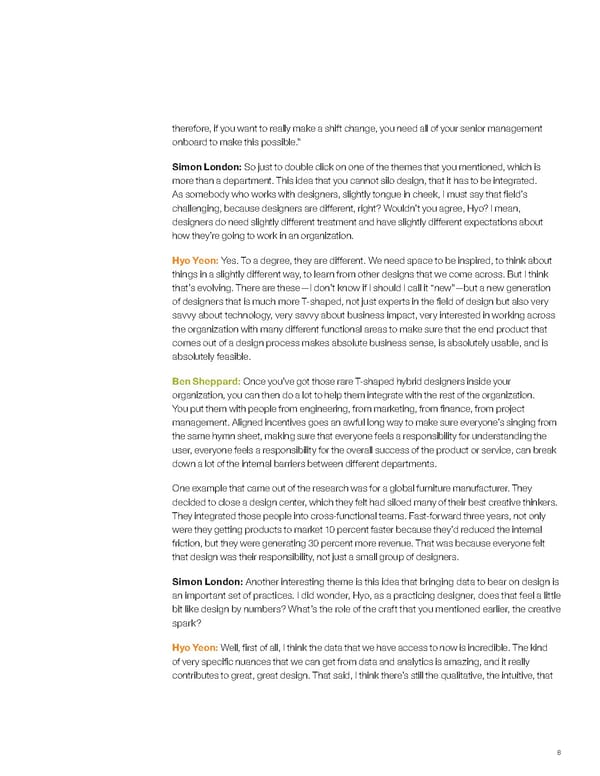therefore, if you want to really make a shift change, you need all of your senior management onboard to make this possible.” Simon London: So just to double click on one of the themes that you mentioned, which is more than a department. This idea that you cannot silo design, that it has to be integrated. As somebody who works with designers, slightly tongue in cheek, I must say that field’s challenging, because designers are different, right? Wouldn’t you agree, Hyo? I mean, designers do need slightly different treatment and have slightly different expectations about how they’re going to work in an organization. Hyo Yeon: Yes. To a degree, they are different. We need space to be inspired, to think about things in a slightly different way, to learn from other designs that we come across. But I think that’s evolving. There are these—I don’t know if I should I call it “new”—but a new generation of designers that is much more T-shaped, not just experts in the field of design but also very savvy about technology, very savvy about business impact, very interested in working across the organization with many different functional areas to make sure that the end product that comes out of a design process makes absolute business sense, is absolutely usable, and is absolutely feasible. Ben Sheppard: Once you’ve got those rare T-shaped hybrid designers inside your organization, you can then do a lot to help them integrate with the rest of the organization. You put them with people from engineering, from marketing, from finance, from project management. Aligned incentives goes an awful long way to make sure everyone’s singing from the same hymn sheet, making sure that everyone feels a responsibility for understanding the user, everyone feels a responsibility for the overall success of the product or service, can break down a lot of the internal barriers between different departments. One example that came out of the research was for a global furniture manufacturer. They decided to close a design center, which they felt had siloed many of their best creative thinkers. They integrated those people into cross-functional teams. Fast-forward three years, not only were they getting products to market 10 percent faster because they’d reduced the internal friction, but they were generating 30 percent more revenue. That was because everyone felt that design was their responsibility, not just a small group of designers. Simon London: Another interesting theme is this idea that bringing data to bear on design is an important set of practices. I did wonder, Hyo, as a practicing designer, does that feel a little bit like design by numbers? What’s the role of the craft that you mentioned earlier, the creative spark? Hyo Yeon: Well, first of all, I think the data that we have access to now is incredible. The kind of very specific nuances that we can get from data and analytics is amazing, and it really contributes to great, great design. That said, I think there’s still the qualitative, the intuitive, that 8
 Tapping into the business value of design Page 7 Page 9
Tapping into the business value of design Page 7 Page 9